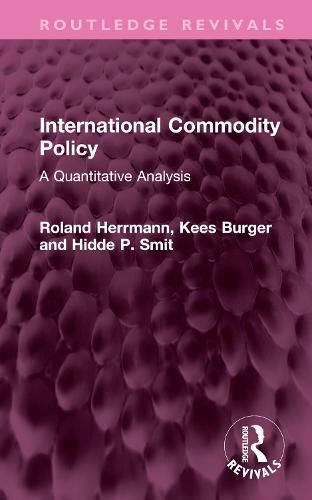Readings Newsletter
Become a Readings Member to make your shopping experience even easier.
Sign in or sign up for free!
You’re not far away from qualifying for FREE standard shipping within Australia
You’ve qualified for FREE standard shipping within Australia
The cart is loading…






Originally published in 1993, this book provides an excellent analysis of commodity policies internationally during the late 20th Century. It discusses 2 major methods of market regulation: price stabilization - based on buffer stocks or export quotas - and compensatory finance. The authors analyse whether major commodity policies have reached their primary objectives and to what extent they have had economic side effects. Discussion of more general policy issues centres around three international commodity agreements for coffee, rubber and cocoa. The authors also look at the policies adopted by individual nations to regulate commodity trading and assess to what extent they have reached their objectives. A discussion of the intervention of the International Monetary Fund and STABEX assesses the degree of stability they can provide in a highly volatile and variable environment. Nearly 30 years later, volatile world commodity markets are still a major issue in the policy dialogue. Although topics, policy instruments and concepts have changed, this book remains a fundamental contribution to the study of international commodity policy. It will be of great interest to students of commodity policy and economic development and economists in national and international organizations dealing with market stabilization.
$9.00 standard shipping within Australia
FREE standard shipping within Australia for orders over $100.00
Express & International shipping calculated at checkout
Originally published in 1993, this book provides an excellent analysis of commodity policies internationally during the late 20th Century. It discusses 2 major methods of market regulation: price stabilization - based on buffer stocks or export quotas - and compensatory finance. The authors analyse whether major commodity policies have reached their primary objectives and to what extent they have had economic side effects. Discussion of more general policy issues centres around three international commodity agreements for coffee, rubber and cocoa. The authors also look at the policies adopted by individual nations to regulate commodity trading and assess to what extent they have reached their objectives. A discussion of the intervention of the International Monetary Fund and STABEX assesses the degree of stability they can provide in a highly volatile and variable environment. Nearly 30 years later, volatile world commodity markets are still a major issue in the policy dialogue. Although topics, policy instruments and concepts have changed, this book remains a fundamental contribution to the study of international commodity policy. It will be of great interest to students of commodity policy and economic development and economists in national and international organizations dealing with market stabilization.